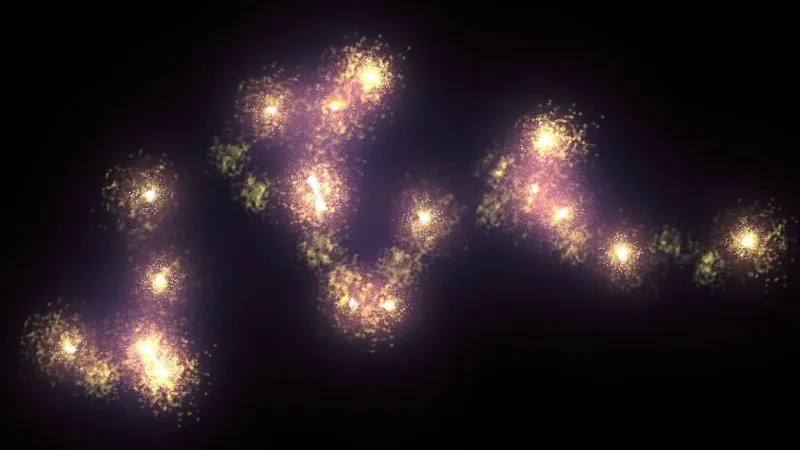
Revolutionary Interactive Map Unveils Hidden Functions of Human Cell Proteins
2025-04-09
Author: Wei
A Breakthrough in Cell Mapping!
For centuries, scientists have endeavored to map the intricate world of human cells. Despite advances since the invention of the microscope over 400 years ago, many vital components remain unexplored.
Leah Schaffer, Ph.D., a postdoctoral research scholar at UC San Diego, emphasizes, "We recognize all the proteins within our cells, but understanding their interactions and collective functions across different cell types is still largely a mystery."
Collaboration Brings New Insights
Schaffer and a team of researchers from UC San Diego, Stanford University, Harvard Medical School, and the University of British Columbia have joined forces to create a groundbreaking interactive map of U2OS cells, linked to pediatric bone tumors. Their significant findings were published in the esteemed journal, Nature.
Using advanced imaging and detailed analysis of protein interactions, the team charted the subcellular architecture and complex protein assemblies.
Unlocking the Secrets of Protein Functions
This innovative map has unveiled previously unknown functions of proteins, shedding light on how mutations contribute to diseases like childhood cancers. Researchers aimed not only to expand knowledge on U2OS cells but also to establish a foundation for mapping other cell types in the future.
Trey Ideker, Ph.D., a co-senior author, notes the irony: "Despite basic cell biology believing we comprehensively understand cells, we lack a proper catalog of their components and functions."
Detailed Protein Interactions Revealed
Employing a technique called affinity purification, researchers systematically isolated individual proteins to investigate their interactions. They meticulously analyzed over 20,000 fluorescent images to illuminate the locations of proteins recognized by the Human Protein Atlas.
This comprehensive approach documented 275 distinct protein assemblies from over 5,100 proteins present in U2OS cells.
A Shift in Scientific Understanding
Emma Lundberg, Ph.D., another co-senior author, emphasizes a pivotal realization: "Historical views assumed one gene equals one protein with one function. We now know many proteins are multifunctional, and our study illustrates the importance of integrating diverse data to uncover these properties."
Revolutionary Discoveries in Protein Functions
The researchers identified an astounding 975 previously unknown functions within the map. Notable proteins like C18orf21, linked to RNA processing, and DPP9, crucial in interferon signaling, illustrate the map’s potential for revealing critical cellular roles.
AI Enhancing Biological Discovery
The team harnessed AI, specifically GPT-4, to expedite their research. By querying this advanced model for protein functions and their collaborations, they swiftly condensed vast scientific literature into insightful data that shaped the map’s findings.
Clara Hu, a key researcher, notes, "This tool significantly reduced research time, allowing us to explore unbiased connections among proteins and their roles in disease contexts."
A New Way to Understand Childhood Cancer
By pinpointing mutated proteins, the researchers identified 21 protein assemblies commonly altered in childhood cancers, linking 102 specific mutated proteins to cancer development. Their approach marks a crucial shift in cancer research methodology, emphasizing the need to investigate the cellular machinery above individual mutations.
Schaffer likens navigating the U2OS cell map to exploring an online geographical map, offering users the ability to zoom in and discover the precise location of various protein communities.
A Bright Future for Cellular Research
As researchers refine the map, the potential benefits extend beyond understanding childhood cancers. This U2OS cell atlas could serve as a vital blueprint for mapping other cell types and leveraging AI to uncover the functions of less understood proteins, ultimately unveiling the mechanisms behind numerous diseases.



 Brasil (PT)
Brasil (PT)
 Canada (EN)
Canada (EN)
 Chile (ES)
Chile (ES)
 Česko (CS)
Česko (CS)
 대한민국 (KO)
대한민국 (KO)
 España (ES)
España (ES)
 France (FR)
France (FR)
 Hong Kong (EN)
Hong Kong (EN)
 Italia (IT)
Italia (IT)
 日本 (JA)
日本 (JA)
 Magyarország (HU)
Magyarország (HU)
 Norge (NO)
Norge (NO)
 Polska (PL)
Polska (PL)
 Schweiz (DE)
Schweiz (DE)
 Singapore (EN)
Singapore (EN)
 Sverige (SV)
Sverige (SV)
 Suomi (FI)
Suomi (FI)
 Türkiye (TR)
Türkiye (TR)
 الإمارات العربية المتحدة (AR)
الإمارات العربية المتحدة (AR)